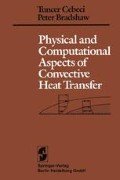Abstract
If the typical temperature difference in a gas flow is an appreciable fraction of the absolute temperature, the typical density difference will be an appreciable fraction of the absolute density, and the density appearing in the velocity-field equations can no longer be taken as constant. Instead, as in the buoyant flows of Chapter 9, the momentum and energy equations must be solved simultaneously since they are “coupled,” i.e., density appears in the momentum equation and is linked through an equation of state to the dependent variable of the energy equation.
Access this chapter
Tax calculation will be finalised at checkout
Purchases are for personal use only
Preview
Unable to display preview. Download preview PDF.
References
Illingworth, C. R.: Steady flow in the laminar boundary layer of a gas. Proc. Roy. Soc. A199: 533 (1949).
Stewartson, K.: Correlated compressible and incompressible boundary layers. Proc. Roy. Soc. A200: 84 (1949).
Liepmann, H. W. and Roshko, A.: Elements of Gas Dynamics, Wiley, New York, 1957.
Seddon, J.: The flow produced by interaction of a turbulent boundary layer with a normal shock wave of sufficient strength to cause separation. Aero Res. Council RandM 3502 (London), 1960.
Oswatitsch, K. and Wieghardt, K.: Theoretical investigations on steady potential flows and boundary layers at high speed. Aero Res. Council Rep. 10356 (London), 1946.
Lighthill, M. J.: On boundary layers and upstream influence. II. Supersonic flows without separation. Proc. Roy. Soc. A217: 478 (1953).
Stewartson, K.: Multistructured boundary layers on flat plates and related bodies. Adv. Appl. Mech. 14: 145 (1974).
Smith, F. T.: On the high Reynolds number theory of laminar flows. IMA J. Appl. Math. 28: 207 (1982).
Chapman, D. R., Kuehn, D. M., and Larson H. K.: Investigation of separated flows in supersonic and subsonic streams with emphasis on the effect of transition. NACA Rep. 1356, 1958.
Carter, J. E.: Numerical solution of the Navier—Stokes equations for the supersonic laminar flow over a two-dimensional compression corner. NASA Rep. TR-R-385, 1972.
Werle, M. J. and Vatsa, V. N.: A new method for supersonic boundary-layer separation. AIAA J. 12: 1491 (1974).
Lewis, J. E., Kubota, T., and Lees, L.: Experimental investigation of supersonic laminar two-dimensional boundary-layer separation in a compression corner with and without cooling. AIAA J. 6: 7–14 (1968).
Reyhner, T. A. and Flügge-Lotz, I.: The interaction of a shock wave with a laminar boundary layer. Int. J. Non-Linear Mech. 3 (2): 173 (1968).
Veldman, A. E. P.: A numerical method for the calculation of laminar incompressible boundary layers with strong-inviscid interaction. NLR TR 79023L, 1979.
Cebeci, T., Stewartson, K., and Williams, P. G.: Separation and reattachment near the leading edge of a thin airfoil at incidence. AGARD Symposium on Computation of Viscous-Inviscis Interaction Flows, Colorado Springs, 1980.
Cebeci, T., and Schimke, S. M.: The calculation of separation bubbles in interactive turbulent boundary layers. J. Fluid Mech. 131: 305 (1983).
LeBalleur, J. C.: Couplage visqueux-non visqueux: analyse du problème incluant décollements et ondes de choc. La Rech. Aèrosp. n° 1977–6, 349. English translation in ESA TT476, 1977.
LeBalleur, J. C.: Couplage visqueux-non visqueux: méthode numérique et applications aux écoulements bidimensionnels transsoniques et supersoniques. La Rech. Aèrosp. n° 1978–2, 67–76 English translation in ESA TT496, 1978.
Carter, J. and Womom, S. F.: Solutions for incompressible separated boundary layers encluding viscous-inviscid interaction in Aerodynamic Analysis Requiring Advanced Computers. NASA SP-347, 1975, p. 125.
Rott, N. J.: Compressible laminar boundary layer on a heat-insulated body. 332 Coupled Laminar Boundary Layers J. Aero. Sci. 20: 67 (1953).
Cohen, C. B. and Reshotko, E.: The compressible laminar boundary layer with heat transfer and arbitrary pressure gradient. NACA Rep. 1294, 1956.
Monaghan, R. J.: Effects of heat transfer on laminar boundary-layer development under pressure gradients in compressible flow. Aero Res. Council RandM 3218, 1961. (Contains results of unpublished work by Monaghan and Crabtree.)
Stewartson, K.: On supersonic laminar boundary layers near convex corners. Proc. Roy. Soc. A319: 289 (1970).
Author information
Authors and Affiliations
Rights and permissions
Copyright information
© 1984 Springer-Verlag Berlin Heidelberg
About this chapter
Cite this chapter
Cebeci, T., Bradshaw, P. (1984). Coupled Laminar Boundary Layers. In: Physical and Computational Aspects of Convective Heat Transfer. Springer, Berlin, Heidelberg. https://doi.org/10.1007/978-3-662-02411-9_10
Download citation
DOI: https://doi.org/10.1007/978-3-662-02411-9_10
Publisher Name: Springer, Berlin, Heidelberg
Print ISBN: 978-3-662-02413-3
Online ISBN: 978-3-662-02411-9
eBook Packages: Springer Book Archive

